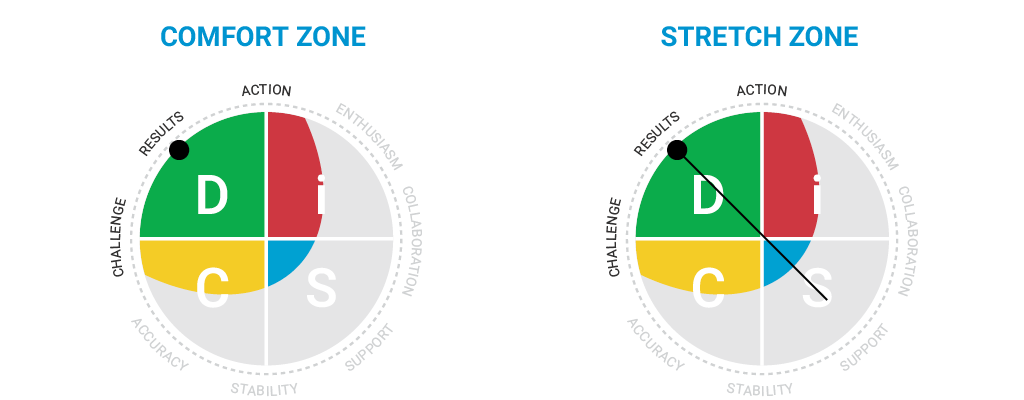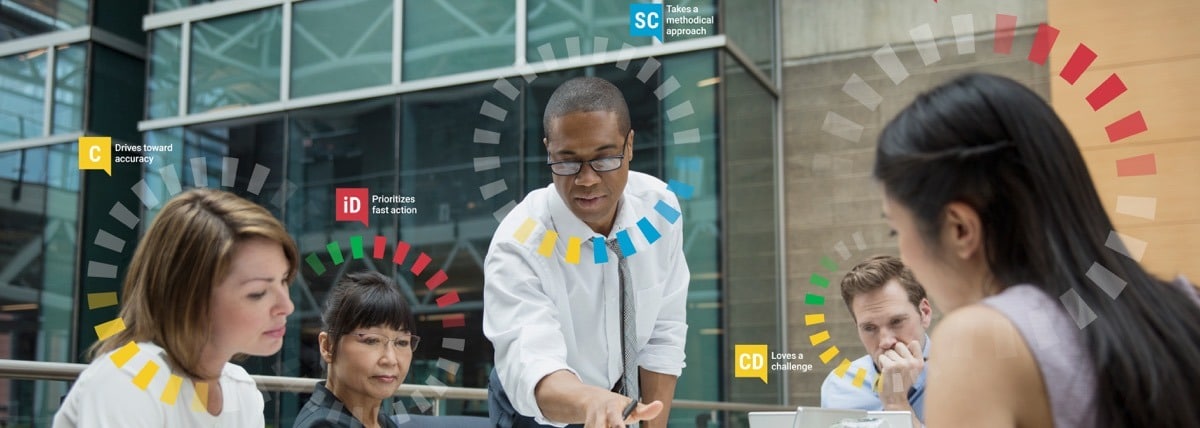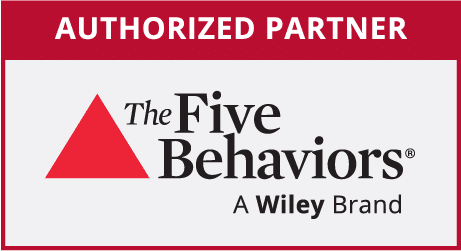
DiSC® concept of stretch
We all benefit from stretching into other styles
The continuous nature of the DiSC circle also helps people understand the idea of “stretch.” It is helpful to think of your style as your home base or comfort zone. When a person moves into a DiSC style outside their own and exercises those types of behaviors, we refer to that as flexing or stretching.
The image above on the left illustrates an individual’s DiSC style through a dot placement within the circumplex. The shading around the dot represents priorities or the primary areas where that person’s energy is focused. This all creates a story around a person’s behavioral comfort zone.
The image above on the right is a demonstration of stretch, where a person quite literally stretches across the circumplex and outside their comfort zone in order to more effectively connect with a different DiSC style. Everyone is a blend of all four DiSC styles, and we all have the ability to stretch outside our behavioral comfort zone. It’s important to remember that the further we stretch, the more energy is required.
There are lots of different ways to stretch. To keep this post light, we thought it would be fun to present you with one example of stretch for each of the four core DiSC styles:

Of course, the idea of stretch goes much deeper and wider than this. But in skimming the surface, you can see how implementing Everything DiSC gives people the footing they need to reach outside their comfort zones.
Stretching Outside Your Behavioral Comfort Zone
Someone with a C style may be very comfortable working alone on analytical projects that require accuracy. At times, however, this person may be called on to mingle with strangers at a professional function.
In this case, the person is being asked to stretch across the circle toward the i style. Now, someone with the C style who has a dot close to the center of the circle will probably find this mingling distasteful but manageable. On the other hand, someone with a C style whose dot is located on the edge of the circle is more likely to find this mingling highly stressful. In the second case, the person has had to travel farther outside their comfort zone, and that will require more energy.
So, as a general rule, people with dots located close to the center usually have a somewhat easier time adopting foreign DiSC styles when the situation calls for it. People whose dots are on the edge of the circle may have to stretch more (and experience more stress) if they want to adopt another style. On the other hand, because these people have more pronounced DiSC styles, those styles are often accompanied by some very distinct strengths.
Stretch, Learn, GROW
Flexing becomes easier as we practice it. The more we stretch into an unfamiliar or uncomfortable behavior, the more flexible we get. The analogy of a rubber band pinned to your DiSC dot can be helpful. It takes more energy the farther you pull the band. So moving a little way into the style next to yours takes less energy than stretching all the way across the circle. The band becomes easier to stretch the more you stretch it, and always moves back to its original position when you stop.
Our ability to flex is one reason why we don’t use DiSC as a reason not to adapt or as an excuse for bad behavior. Statements like “I’m a C style, you’ll just need to learn not to take my criticisms personally” encourage stereotypes and rigidity, which is the antithesis of what Everything DiSC stands for.
The Everything DiSC Agile EQ model is a good example of how DiSC promotes flexing. It speaks to mindsets rather than styles, but the concept of flexing or stretching is obvious. The model proposes that an emotionally intelligent person is one who:
- Recognizes which mindsets are most appropriate in a given situation, and
- Stretches to use those mindsets, regardless of how comfortable they are.
Stretching into other styles may feel uncomfortable at the moment, but know that you are in fact doing yourself a favor. We often level up through situations that challenge us, and it’s through these challenges that our continued learning and growth take place.
Sources:
https://www.discprofile.com/fac-sup/tips/flex
https://www.everythingdisc.com/insights-to-action/if-you-arent-stretching-you-arent-learning.aspx
You might also be interested in






